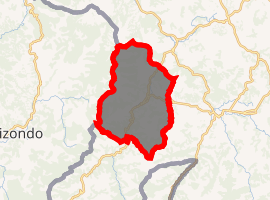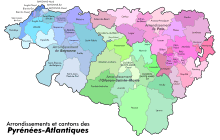Saint-Étienne-de-Baïgorry
Saint-Étienne-de-Baïgorry (Basque: Baigorri) is a commune in the Pyrénées-Atlantiques department in south-western France, located at the same time in the former province of Lower Navarre. It borders the municipality of Baztan to the west (Spain, access via the Izpegi Pass).
Saint-Étienne-de-Baïgorry Baigorri | |
|---|---|
 A baserri in Saint-Étienne-de-Baïgorry | |
Location of Saint-Étienne-de-Baïgorry 
| |
 Saint-Étienne-de-Baïgorry  Saint-Étienne-de-Baïgorry | |
| Coordinates: 43°10′02″N 1°20′43″W | |
| Country | France |
| Region | Nouvelle-Aquitaine |
| Department | Pyrénées-Atlantiques |
| Arrondissement | Bayonne |
| Canton | Montagne Basque |
| Intercommunality | CA Pays Basque |
| Government | |
| • Mayor (2001–2008) | Jean-Baptiste Lambert |
| Area 1 | 69 km2 (27 sq mi) |
| Population (2017-01-01)[1] | 1,477 |
| • Density | 21/km2 (55/sq mi) |
| Time zone | UTC+01:00 (CET) |
| • Summer (DST) | UTC+02:00 (CEST) |
| INSEE/Postal code | 64477 /64430 |
| Elevation | 146–1,049 m (479–3,442 ft) (avg. 273 m or 896 ft) |
| 1 French Land Register data, which excludes lakes, ponds, glaciers > 1 km2 (0.386 sq mi or 247 acres) and river estuaries. | |
It is the main access to the Aldudes valley, having nearby the Castle, Echauz Castle, Château d'Etxauz,[2] the river through the place being known as the river Nive des Aldudes.
The town is home to the renowned Day of Navarre[3] (Basque: Nafarroa Eguna), a festival attracting a massive turnout (by thousands) from the Spanish and French side of Navarre in early May intended to strengthen ties between both Navarrese territories and affirming their common Basque identity.
Canton


Saint-Étienne-de-Baïgorry was the chief town of the former canton of Saint-Étienne-de-Baïgorry. Its 11 communes had some 5,727 inhabitants on some 311 km2 in 2006, with decreasing population. In 2015, the canton was merged into the new canton of Montagne Basque.[4]
French Communes limiting with the town of Saint-Étienne de Baïgorry
- Bidarray, Northwards. 652 inhabitants in 2006. Some 30 km2. 43°16′3″N 1°20′38″W
- Saint-Martin-d'Arrossa- North-East. 462 inhabitants in 2006. 43°14′21″N 1°18′43″W
- Irouléguy. East. Famous vineyards for many years. 316 inhabitants in 2006, 43°10′40″N 1°18′01″W
- Anhaux. South-West.280 inhabitants in 2006. 12.3 km2., 43°10′9″N 1°17′28″W
- Banca. South. Some 373 inhabitants in 2006, 43°7′39″N 1°22′23″W
Demography
Saint-Étienne-de-Baïgorry has 1617 inhabitants, as of the 2006 census.
Transportation
Set in a mountainous area, Baigorri is communicated by departmental roads D15 and D948, with a coach line offering service to Ossès (Basque Ortzaize) within TER Aquitaine's network.
The Area as a part of the French GR10, French footpaths,(Grand Randonnée 10)[5]
Main sights
.jpg)
- Saint-Etienne church, in a Viscounty created in 1033 by King Sancho III of Navarre, is mentioned in documents of 1253, but with a Baroque retable of the 17th century displaying the stoning of 1st century AD Saint Étienne[6]
- Château d'Etchaux, built in the 16th century by Viscount of Baïgorry[7]
Coat of arms
.svg.png)
The meaning in Basque is the “red bank of the river”, in this case the river Nive, flowing through Bayonne and discharging the waters in the 324 km long Adour River.
Notable people
- Jean Isidore Harispe, 1st Comte Harispe, (Saint-Étienne-de-Baïgorry, 7 December 1768 - Lacarre, 26 May 1855), was a distinguished French soldier of the Revolutionary and Napoleonic Wars, as well as of the following period. Harispe was created a Marshal of France in 1851.
- Jean-Baptiste Etcheverry, general councillor of Basses-Pyrénées and deputy of the Second French Empire, was born in Saint-Étienne-de-Baïgorry in 1805.
References
- "Populations légales 2017". INSEE. Retrieved 6 January 2020.
- Jedecouvrelafrance.com: Château d'Etxauz
- Rayon Basque.com: Journée de la Navarre / Nafarroaren Eguna Archived 2008-10-25 at the Wayback Machine (in French)
- "Décret n° 2014-248 du 25 février 2014 portant délimitation des cantons dans le département des Pyrénées-Atlantiques | Legifrance". Retrieved 2017-07-11.
- apparent orography of some 260 Km path of GR10
- French Ministry of Culture: église paroissiale Saint-Etienne (in French)
- French Ministry of Culture: château d'Etchaux (in French)
- INSEE commune file
- http://www.euskomedia.org/aunamendi/63865 . An account on the Basque historic works by French born researcher Jean de Jaurgain, (Ossas, (Zuberoa), 1842 - Ziburu, (Laburdi), Lower Navarre, 18 March 1920)
- Arnaud d'Oihenart et sa famille, París, 1885, by Jean de Jaurgin.